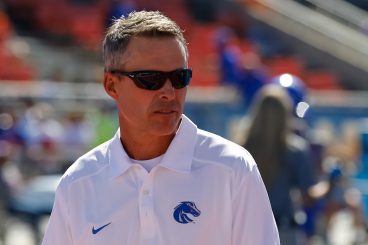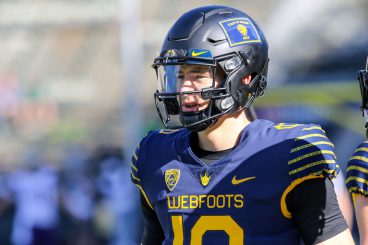Mark Helfrich and Oregon football 2016: So much written, so much argued, so much uncertainty. Amidst the turmoil, one thing is clear: The program now stands at a critical crossroads and turns taken here … or not taken … will shape Ducks athletics for many years to come. In short, the Roman Empire is falling and we must decide: Have we come to praise Caesar or to bury him. I come to bury him.

The crumbling of the empire?
Firing coach Helfrich, or any head coach for that matter, is never easy. We’ve all seen the downside. The potential loss of continuity and identity from a regime change can sometimes lead to a decade long loss of relevance. One need only look at Michigan before Jim Harbaugh, or Washington before Chris Petersen.
In some cases, NCAA sanctions play a role, but the constant that determines long-term success (or failure) for a program is coaching – specifically, head coaching. It’s the most impactful position in all of sports, and it explains why the truly gifted are paid such exorbitant salaries, and why they are arguably worth every penny. Love it or hate it, it’s been proven that football is the economic engine that drives intercollegiate athletics.
It’s also a powerful force within the local economy. Doubt me? Check out hotel prices in Eugene on game weekends. I guarantee you no one is paying 3-bills a night for a 3-9 team … or $100+ for game tickets … or $40 for a T-shirt. I could go on. At Oregon, Helfrich is the conductor of this engine, but as time passes, he’s proving that he’s not the right conductor.

Phil Knight and Rob Mullens in a better time.
Four years ago Rob Mullens and the powers that be were standing at a similar crossroads. Chip Kelly was leaving and the decision to blow it up and undertake a national search for a new coach, or keep the status quo and hire from within, loomed large. He chose the latter, and there were valid reasons for that decision. Kelly, an exceptional talent, had taken the program to unprecedented heights. For consecutive years he’d recruited well (on BOTH sides of the ball) and the Ducks were well stocked with talent. In addition, he hammered out a blueprint for “The Oregon Way,” a virtual how-to guide for running a program, incorporating his concepts on scheme, technique, focus, attitude, workouts and diet. Lastly, there was Marcus Marriota, probably the best QB to ever wear the Green.

Coach Chris Petersen while at Boise State.
Bringing in a new coach and a new system to that team and to those players would have been difficult. Kelly had built the Ferrari that was the Oregon Ducks, and four years ago Mullens determined that he only needed a competent driver for that Ferrari … and so, Helfrich. At the time, much as I desperately wanted Peterson, I understood and accepted that decision.
Today, looking back, I still think the decision had merit. After all, we got Marcus, we got another shot at the Natty, and let’s face it, it was glorious.
But here’s the point: Ferrari’s are beautiful things, but they are Ferrari’s and at some point Ferrari’s always break down. And while Helfrich may be a competent driver, he doesn’t possess the skills to diagnose and fix what’s now broken. What made Kelly unique was that he was not only a great driver, he was also a great architect. In short, he built the freaking car!
Far better writers than I have already chronicled the highs and lows of the Mark Helfrich era at Oregon (see Ken Woody or John Canzano). But let’s look at two areas of major concern that have taken root under the Helfrich regime: recruiting and program identity.
Recruiting: It’s pretty simple, in college football success on the field is a direct result of success in the living room. Under Kelly, and even in some instances under Mike Bellotti, Oregon was the most talented program in the conference. It isn’t now.
To be clear, I’m not sold on recruiting class rankings, as many times a kid might fit well in your scheme and not another, or may have a particularly high ceiling for future development. But under Helfrich (modest rankings aside), Oregon is now thin at linebacker, D-line, defensive back, QB and O-line. Granted, injuries like those experienced on the O-line play a significant role, but they’re part of the sport, and it’s why it takes a special talent to consistently groom players and have them ready to contribute when the opportunity arises. “Next Man Up” is a great philosophy, but only when you have talent waiting in the wings.

Justin Herbert in his first start as an Oregon Ducks.
The QB position is the most glaring example. Strong programs stock that position like cordwood. Two will ultimately transfer to another program, two will be switched to play defense and the other two will compete for the starting job.
Last year, there was no excuse for the coaching staff to enter the season with the belief that either Jeff Lockie or Taylor Alie were Pac-12 caliber quarterbacks. Helfrich had seen them every day in practice for over two years. Vernon Adams was lightening in a bottle, but as the season played out we quickly saw that he had no understudy.
To believe that you could pull off that stunt again this year with Dakota Prukop was pure hubris, or pure lunacy. We’re all watching to see what Justin Herbert can bring to the table, but for god’s sake, you’re Oregon and you can’t consistently recruit quarterbacks? What does that say about you as a coach?
Identity: Back in the dark days you watched the Ducks with one eye on the play and the other eye on the officials. It was a built in five-second delay, because regardless of how great the play was you held your breath and waited those five agonizing seconds for that yellow flag to appear. It was our operational conditioning, and a particularly crappy way to watch a football game. Rich Brooks spent years trying to clean up that sloppy play … Bellotti was better … and Kelly succeeded. Under Chip, the play was hard, fast and clean. It became our identity, and baby, we got used to it.

Charles Nelson with the media.
There was an excellence, a flow, and we watched with great pride and certainty that our Ducks would enter a game focused and sharp. Sure there were a few exceptions (Stanford, Boise State) but those games were outliers, not the norm. Under Helfrich I no longer have that feeling of certainty, whether it be in preparation, scheme or execution. Too often of late we see the critical penalty or turnover negating a drive. We see the unfocused effort, the poor technique, the lack of team cohesion. You even begin to see it in the uneven play of some of the stalwarts like Charles Nelson and Royce Freeman.
The play on the field is no longer fast and no longer clean. Rather, we are witnessing the slow, painful unraveling of the football culture at Oregon, and it’s hard to watch. Does Helfrich possess the requisite skills to fix the problem? Let me say it this way: sadly, there is a fear factor that every great coach seems to possess, even those labeled as “player’s coaches.” Call it a force of will. Nick Saban, Harbaugh, Urban Meyer are extreme examples, but we saw it with Kelly. It’s my way or no way. Lines are drawn and repercussions swift. It becomes your program’s culture, it’s a binding agent and identity, a thing to trust and rely upon when all else is going against you.
If Helfrich has that culture defining force of will he hides it well. As Kelly’s recruits graduate, his stamp on the program begins to fade and, gradually, under Helfrich, we are seeing a different culture emerge. Emotion aside, do you like what you see?

Coach Mark Helfrich
I said earlier that blowing up something to fix it is never a thing to relish. But sometimes it’s simply the right thing to do. In three and a half years, Helfrich has taken a perfectly good ship and sailed it onto the shoals. He may only win 3 games this year. Think about that, and think about how swift and steep a fall that truly is. Think about how much was spent, in effort, in time and in money to create the brand that the O so fragilely represents.
To those in support I ask: What in Helfrich’s coaching background gives you the confidence that he is the right man to turn things around? Oregon aside, Helfrich has never been a head coach at any level, and his tenure as OC in Colorado was mediocre at best. Remember, this is not a question about the man, it’s a question about the job, and the skills required for success. I ask only that you take a hard, unbiased look at the program as it now stands under Helfrich’s watch. What do your eyes tell you?
Marc Burton
Bay Area, California (U of O 1978)
Top Photo Credit: wikimedia.commons
Disclaimer: Readers: Every writer on FishDuck.com is allowed to express their opinion in their articles. However, articles do not represent the views of the other writers, editors, coaching consultants, management, or the principals of FishDuck.com. Charles Fischer
These are articles where the writer left and for some reason did not want his/her name on it any longer or went sideways of our rules–so we assigned it to “staff.” We are grateful to all the writers who contributed to the site through these articles.

